Choosing the Right Material for Your Bathroom Floor
When it comes to designing the perfect bathroom, choosing the right flooring material is one of the most critical decisions. The bathroom floor has to withstand moisture, temperature fluctuations, and regular cleaning, all while contributing to the overall aesthetic of the space. I’ve spent countless hours researching and experimenting with various materials to find the best options that balance style, durability, and practicality.
Ceramic: The Affordable and Versatile Choice
First, I had to consider ceramic tiles, a common and affordable choice for bathroom flooring. Ceramic tiles are loved for their versatility. Whether you prefer the look of traditional stone or something more modern and sleek, ceramic can replicate almost any material at a fraction of the cost. What I love most about ceramic tiles is their wide range of colors, patterns, and finishes. You can create almost any look you desire. Plus, they’re relatively easy to clean, which is essential for a bathroom.
Porcelain: Durability Meets Style
Porcelain tiles quickly became one of my top considerations when I was searching for something that combined beauty with long-lasting durability. They’re denser and less porous than ceramic tiles, which means they’re better suited for handling moisture—an essential factor in bathrooms. Porcelain tiles also have a rich, luxurious feel to them, and they can mimic high-end materials like marble or granite, giving your bathroom an elegant touch without the hefty price tag.
Natural Stone: A Touch of Luxury
If you’re looking to take your bathroom design up a notch, natural stone flooring may be the answer. Marble, slate, and travertine tiles offer a natural, high-end look that simply can’t be replicated with man-made materials. I fell in love with the organic variations in color and texture that only nature can provide. However, natural stone requires regular sealing and maintenance to keep it looking its best, and it’s more expensive than ceramic or porcelain, which may be a deal-breaker for some.
Vinyl: The Budget-Friendly Option
Vinyl flooring has come a long way over the years. It’s no longer considered just a budget-friendly alternative; today’s vinyl floors can mimic everything from wood to stone, offering a stylish and functional choice for bathrooms. What surprised me most when I explored vinyl was how soft and warm it felt underfoot—perfect for a cozy bathroom experience. Plus, it’s waterproof and easy to clean, making it a practical choice for families.
Engineered Wood: Bringing Warmth to the Bathroom
I’ve always loved the look of wood floors, but I hesitated when considering them for the bathroom due to water exposure. That’s when I discovered engineered wood, which combines the natural beauty of hardwood with a moisture-resistant core. This allows you to bring the warmth and character of wood into your bathroom without worrying about warping or water damage. I think it’s a fantastic choice for creating a spa-like, inviting space.
Concrete: The Modern and Durable Option
Concrete is another material that’s gaining popularity in bathroom design. It’s modern, sleek, and incredibly durable. What’s great about concrete is that it can be stained or polished to achieve a variety of looks, from industrial to polished and chic. I found it to be perfect for those who want a modern, minimalist aesthetic with long-lasting durability. However, it can feel cold underfoot, so consider adding radiant heating if you go with this option.
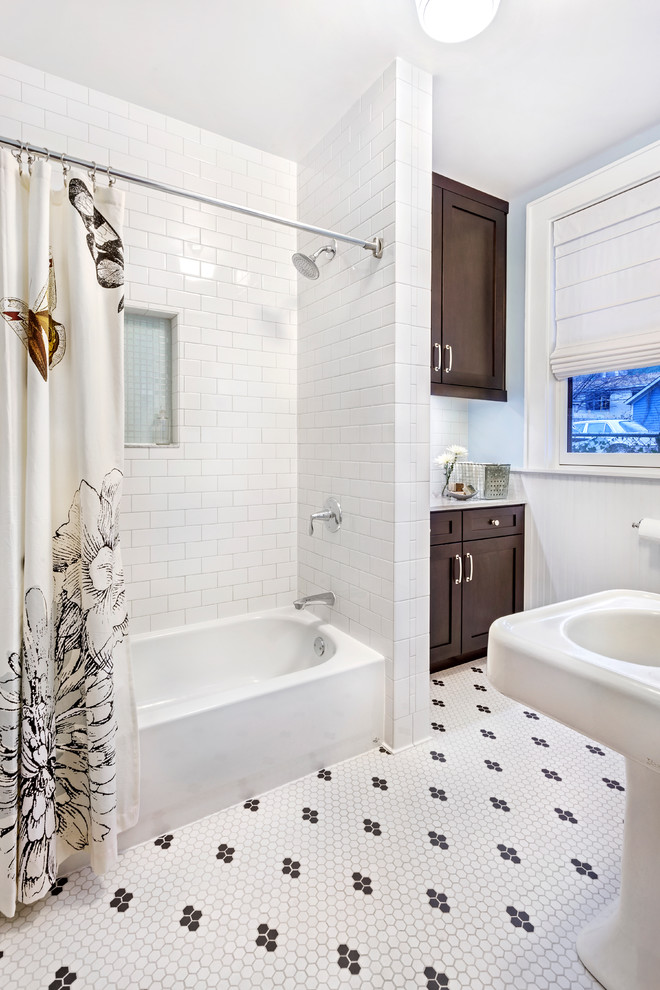
Bold and Beautiful: Unique Patterned Flooring Ideas
I’ve always believed that the bathroom, despite its practical nature, can be one of the most expressive and bold spaces in a home. One way to infuse personality and style into a bathroom is through unique patterned flooring. While many people play it safe with solid colors or subtle designs, I love the idea of using bold patterns to make a statement.
Moroccan-Inspired Tiles: A World of Color
One of my favorite discoveries when searching for bold flooring ideas was Moroccan-inspired tiles. These tiles often feature intricate geometric patterns and vivid colors, making them an instant focal point in any bathroom. I decided to experiment with these in a smaller bathroom and was blown away by the impact. The vibrant colors and patterns transported the space to a different world, creating an exotic and playful atmosphere. If you’re looking to break away from the mundane, these tiles are worth exploring.
Geometric Patterns: Modern and Eye-Catching
Geometric patterns have become increasingly popular in modern bathroom designs. I’ve always been drawn to their clean lines and structured designs, and they offer endless possibilities for creativity. Hexagonal tiles, for example, can be arranged in various patterns to create a truly unique floor. Whether you go for a monochromatic look or mix-and-match colors, geometric patterns can give your bathroom a striking modern edge.
Checkerboard Floors: A Classic with a Twist
The classic black-and-white checkerboard floor is one of those timeless designs that never seems to go out of style. But lately, I’ve seen variations that take this traditional look to the next level. By playing with different tile sizes or introducing unexpected colors, you can breathe new life into the checkerboard pattern. I experimented with a soft pastel checkerboard in a guest bathroom, and the result was a whimsical yet elegant feel. It’s a fun way to add personality while staying within a classic design framework.
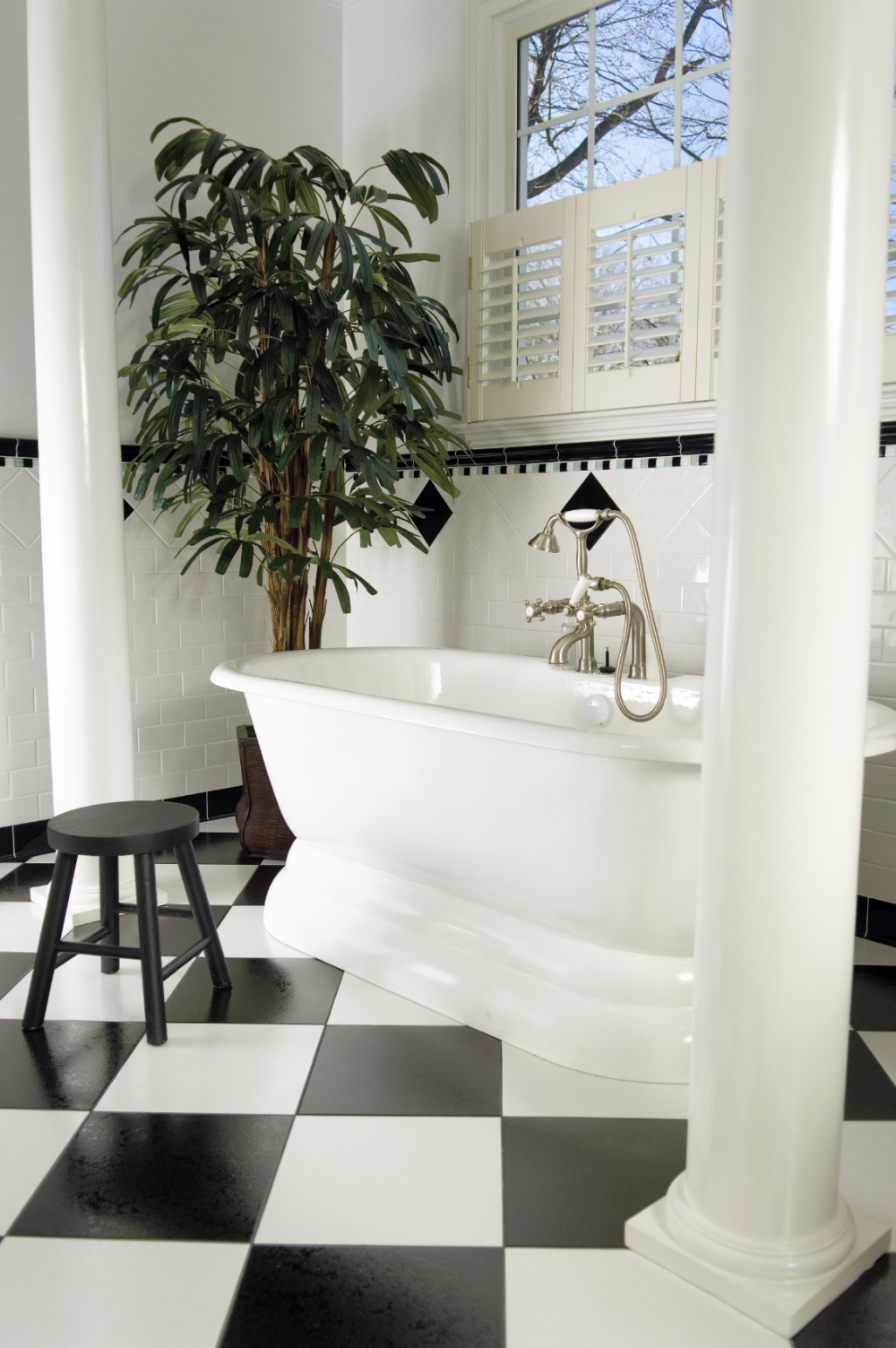
Floral Patterns: Nature-Inspired Beauty
Floral patterned tiles might seem like a bold choice for the bathroom, but when used correctly, they can create a fresh, inviting space that feels like a garden oasis. I was initially hesitant about using florals on the floor, fearing it might be too overwhelming, but by choosing a subtle color palette, I was able to incorporate floral designs without overpowering the space. It brought a touch of nature indoors, and now, every time I walk in, it feels like I’m stepping into a peaceful retreat.
Mixed Patterns: The Art of Contrast
If you’re feeling adventurous, mixing different patterns can create a floor that is truly one of a kind. When I experimented with this idea, I found that combining bold, contrasting patterns worked best when the colors were kept in the same family. For instance, I mixed large hexagonal tiles with smaller geometric tiles, all in shades of gray. The result was a floor that felt dynamic and lively without being too chaotic. Mixing patterns is an excellent way to add depth and interest to your bathroom.
Large-Scale Patterns: Making a Big Impact
Sometimes bigger is better, and this is especially true when it comes to large-scale patterned tiles. These oversized patterns can make a small bathroom feel larger by drawing the eye across the floor. I used a large herringbone pattern in my bathroom, and it completely transformed the space, adding an element of luxury and sophistication. Large-scale patterns are perfect for those who want to make a bold statement without relying on color alone.

Eco-Friendly Bathroom Flooring Solutions
In recent years, I’ve become much more conscious of the impact that home renovations can have on the environment. When I started looking into bathroom flooring options, I made it a priority to find eco-friendly solutions that didn’t sacrifice style or functionality. Thankfully, there are plenty of sustainable materials available that look great and are better for the planet.
Bamboo: A Renewable Resource
One of the first eco-friendly materials I explored was bamboo. Bamboo is a rapidly renewable resource, which means it can be harvested and replenished much faster than traditional hardwoods. When I installed bamboo flooring in my bathroom, I was pleasantly surprised by its durability and how easy it was to maintain. Plus, it has a natural warmth and texture that adds a calming, spa-like feel to the space.
Cork: Soft and Sustainable
Cork flooring is another sustainable option that I love. Made from the bark of cork trees, it’s both renewable and biodegradable. What’s more, cork is soft underfoot, making it incredibly comfortable to walk on, which I found particularly appealing in a bathroom setting. It also has natural insulating properties, keeping the floor warm during colder months—a definite plus in my book!
Recycled Tiles: Giving New Life to Old Materials
Another great way to go green is by using recycled materials. Recycled glass and ceramic tiles are not only beautiful but also environmentally friendly. I used recycled glass tiles in one of my bathroom renovations and was thrilled with the results. They added a unique, reflective quality to the room while also giving me peace of mind knowing that I was reducing waste. There’s something incredibly satisfying about using materials that have been repurposed for a new life.

Linoleum: The Natural Alternative to Vinyl
Often confused with vinyl, linoleum is a natural and eco-friendly material made from renewable resources like linseed oil, cork dust, and wood flour. I was impressed by how durable and water-resistant linoleum is, making it a great choice for bathrooms. It also comes in a wide variety of colors and patterns, so you don’t have to compromise on style when opting for an eco-friendly floor.
Natural Stone: Timeless and Sustainable
Although natural stone requires mining, it’s a durable material that can last for decades, making it a sustainable choice in its own right. I’ve used natural stone tiles in a bathroom project and loved how their unique variations in color and texture brought a sense of natural beauty to the space. With proper care, these floors can stand the test of time, reducing the need for frequent replacements.
Reclaimed Wood: Giving Old Materials New Life
For a truly unique and sustainable bathroom floor, reclaimed wood is an excellent option. Sourced from old buildings, barns, or other structures, reclaimed wood offers a rustic charm that you simply can’t get from new materials. I used reclaimed wood in a bathroom remodel and was amazed at how much character it added to the space. Each plank had its history, and it felt good knowing I was giving new life to old materials.

Waterproof and Durable Options for High-Traffic Bathrooms
In my quest to design a bathroom that could handle heavy usage while still looking great, I quickly realized that choosing waterproof and durable flooring was essential. High-traffic bathrooms—like those used by a busy family or guests—require materials that can stand up to moisture, spills, and frequent foot traffic. Here’s what I discovered about the best options for durability and water resistance.
Porcelain Tiles: The Heavy-Duty Choice
Porcelain tiles emerged as one of my top choices for high-traffic bathrooms. Known for their durability and low water absorption rate, porcelain tiles can handle the rigors of daily use without showing signs of wear. They’re incredibly hard and resistant to scratches, making them ideal for busy bathrooms. I opted for a textured finish to provide additional grip and enhance their functionality. The result was a robust floor that looks elegant and performs well under pressure.
Vinyl Planks: A Flexible and Waterproof Solution
Vinyl planks are another excellent option for high-traffic bathrooms. They offer the look of natural wood or stone while being completely waterproof. When I used vinyl planks in a rental property, I was impressed by their resilience and ease of maintenance. They’re also softer underfoot compared to harder materials, which can make a significant difference in comfort, especially if you’re on your feet a lot.
Rubber Flooring: Durable and Easy to Clean
Rubber flooring might not be the first thing that comes to mind for bathroom design, but it’s worth considering if you need a highly durable and easy-to-clean option. I used rubber tiles in a high-traffic bathroom and found them to be incredibly resilient. They can withstand heavy use and are resistant to mold and mildew, which is crucial in a damp environment. Plus, rubber flooring is cushioned, providing extra comfort and reducing fatigue from standing for long periods.

Slate Tiles: Natural Toughness
For a touch of natural beauty combined with durability, slate tiles are a great choice. I used slate in a high-traffic bathroom and appreciated its rugged texture and natural slip resistance. Slate is known for its ability to handle moisture and heavy use without compromising its appearance. Its unique variations in color and texture also add a distinctive character to the floor.
Engineered Hardwood: A Durable Alternative
While traditional hardwood might not be the best choice for high-moisture areas, engineered hardwood offers a more resilient alternative. It’s designed to handle fluctuations in humidity and temperature better than solid wood. I found that engineered hardwood provides the warm, natural look of wood while being more resistant to warping and swelling. It’s a great way to achieve a luxurious feel in a high-traffic bathroom without sacrificing durability.
Stone Composites: Combining Style and Strength
Stone composite tiles are engineered to combine the best features of natural stone with added durability and water resistance. These tiles are designed to handle high traffic and moisture without the maintenance requirements of natural stone. I used stone composites in a commercial bathroom and was impressed by their performance. They offer a sophisticated look while being resilient enough to withstand constant use.

Mixing and Matching: Combining Different Textures and Colors
I’ve always enjoyed experimenting with different textures and colors in design, and the bathroom is no exception. Mixing and matching flooring materials can create a dynamic and personalized space. Here’s how I navigated the world of combining textures and colors to achieve a unique and visually interesting bathroom floor.
The Contrast of Smooth and Textured
One of my favorite techniques is combining smooth and textured flooring materials. For instance, I paired sleek, polished ceramic tiles with a textured mosaic border in one of my bathrooms. The contrast between the two elements added depth and visual interest to the floor. This approach allows you to highlight specific areas or create a focal point, all while maintaining a cohesive look.
Color Blocking: Bold and Modern
Color blocking is a great way to make a statement with your bathroom floor. I experimented with this technique by using large blocks of contrasting colors, which created a modern and visually striking effect. For example, I used deep blue tiles in one section and paired them with lighter shades of blue in another. This method not only adds a splash of personality but also allows you to play with different hues and patterns.
Combining Patterns for Visual Interest
If you’re feeling adventurous, mixing different patterns can add a lot of character to your bathroom floor. I combined geometric patterns with floral designs in a recent project, choosing complementary colors to tie the look together. The key to success with this approach is to maintain a balance and ensure that the patterns don’t clash. Using a consistent color palette helps create a unified look despite the variety of patterns.

Transitioning Between Materials
Another way to create an interesting floor design is by transitioning between different materials. I used this technique to separate the main bathroom area from a shower space. I chose large-format tiles for the main floor and smaller, textured tiles for the shower area. The transition between the two materials was both functional and visually appealing, creating a distinct separation without disrupting the overall flow of the design.
Using Borders and Insets
Borders and insets are a fantastic way to incorporate multiple materials or colors into your bathroom floor. I used a border of contrasting tiles to frame a central area of patterned flooring, which added a touch of elegance and definition to the space. Insets can also be used to highlight specific areas or create custom designs, adding a personal touch to your bathroom.
Playing with Scale and Proportion
When mixing different textures and colors, playing with scale and proportion can enhance the overall design. For example, I used large, bold tiles in one area and smaller, intricate tiles in another, creating a dynamic visual contrast. This technique helps to highlight different sections of the bathroom and adds a sense of movement and rhythm to the floor design.
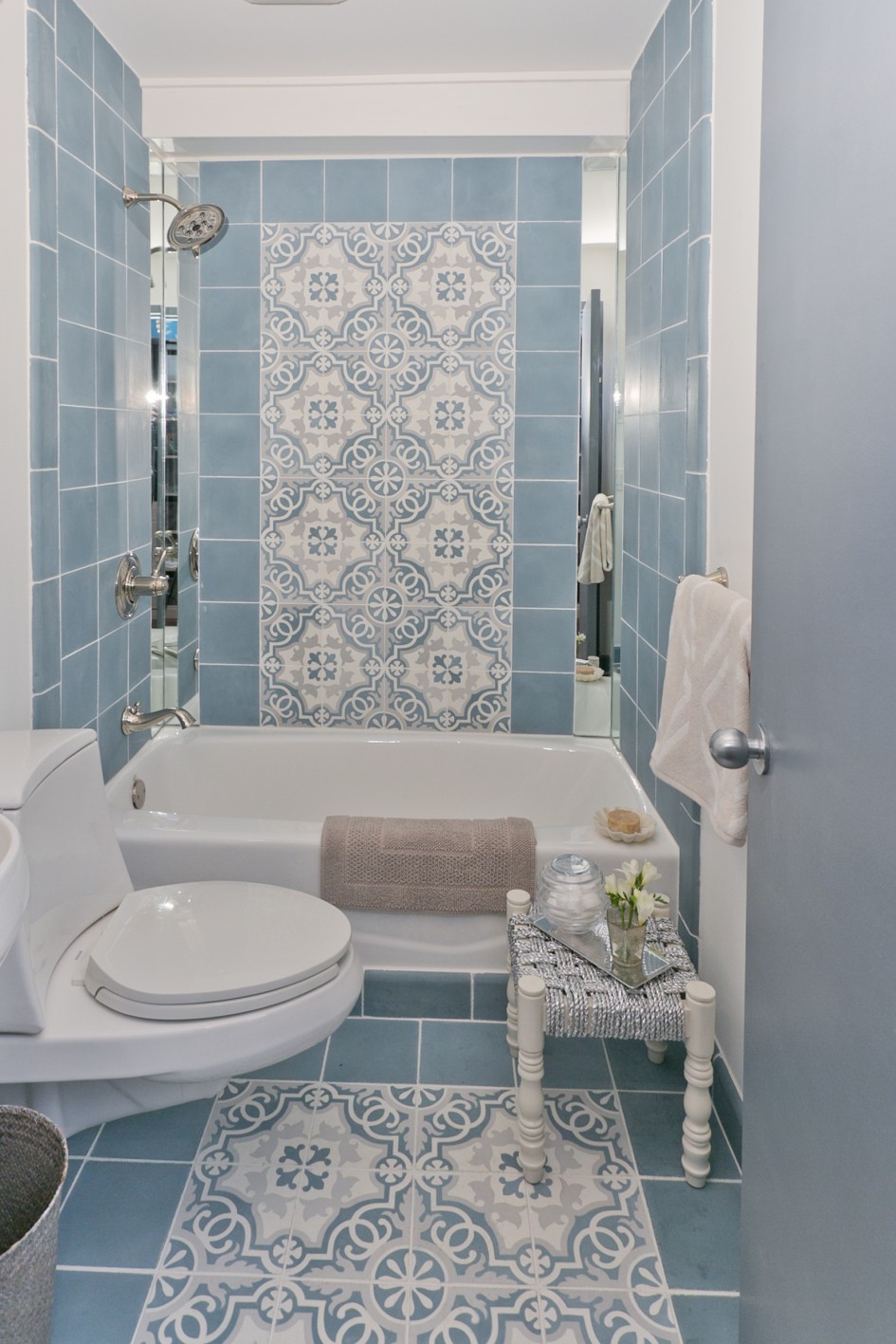
The Impact of Lighting on Your Bathroom Floor Design
Lighting plays a crucial role in how we perceive and experience a space, and the bathroom floor is no exception. The right lighting can enhance the beauty of your floor design, highlight its best features, and create a welcoming ambiance. Here’s how I’ve learned to use lighting to its full potential when designing a bathroom floor.
Natural Light: Enhancing Natural Beauty
I’ve always believed that natural light is one of the best ways to showcase your bathroom floor. When designing a space with ample windows or skylights, I make sure to choose flooring materials that reflect light beautifully. Light-colored tiles or polished surfaces can brighten up the room and make it feel more spacious. I’ve found that natural light can bring out the texture and colors in flooring, creating a warm and inviting atmosphere.
Ambient Lighting: Setting the Mood
Ambient lighting, such as overhead fixtures or recessed lighting, helps create a general illumination that sets the mood of the bathroom. I often use ambient lighting to highlight the overall design of the floor while ensuring that it’s well-lit for practical purposes. Soft, diffused lighting can enhance the subtle textures and patterns in the flooring, creating a soothing and balanced environment.
Task Lighting: Focusing on Specific Areas
For bathrooms with specific areas like a vanity or shower, task lighting can be particularly effective. I’ve used focused lighting to highlight these zones, ensuring that the floor design complements the overall functionality of the space. For example, installing LED strips around the base of a vanity can create a sleek and modern look while drawing attention to the floor underneath.
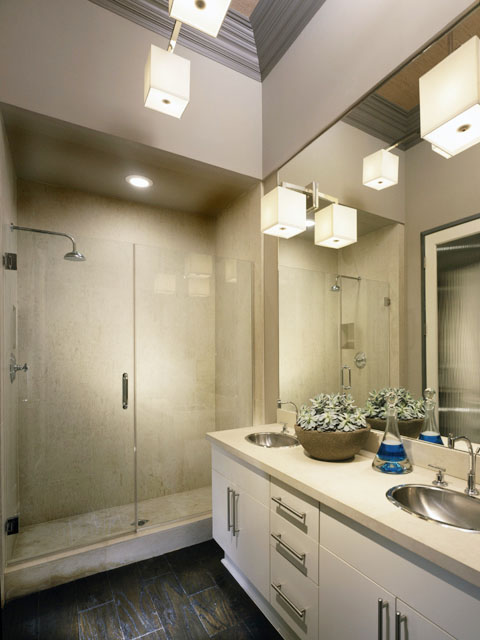
Accent Lighting: Highlighting Unique Features
Accent lighting is perfect for showcasing unique or custom features on your bathroom floor. I used LED spotlights to highlight a mosaic inlay in one of my designs, creating a focal point that draws the eye. Accent lighting can also be used to emphasize patterns, colors, or textures, adding an extra layer of visual interest and depth to the design.
Underfloor Heating: Combining Function and Ambiance
Underfloor heating is not only a practical addition to a bathroom but also enhances the ambiance of the space. I’ve installed radiant floor heating in several bathrooms, and the warmth it provides makes the floor feel cozy and luxurious. This type of heating also eliminates the need for additional floor lamps or heating fixtures, allowing the focus to remain on the design of the floor itself.
Dimmer Switches: Adjusting the Atmosphere
Finally, incorporating dimmer switches can give you control over the lighting intensity, allowing you to adjust the ambiance based on the time of day or your mood. I’ve found that being able to dim the lights can change the entire look of the floor, highlighting different elements and creating a more relaxed or energetic environment as needed.
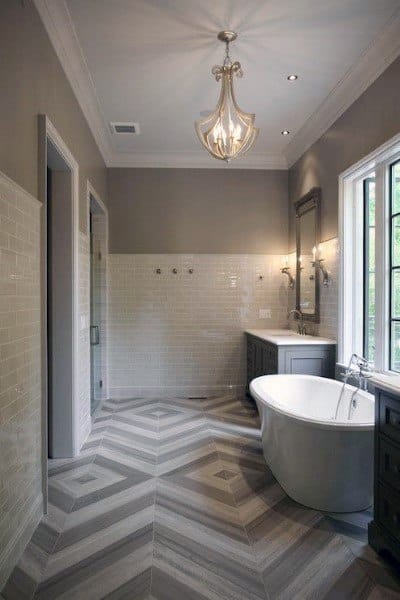
Maximizing Safety and Comfort with Slip-Resistant Floors
Safety and comfort are paramount in bathroom design, particularly when it comes to flooring. Slips and falls are common concerns, especially in wet areas. I’ve made it a priority to choose flooring materials that not only look good but also offer excellent slip resistance and comfort. Here’s what I’ve learned about maximizing safety and comfort in bathroom floors.
Textured Tiles: Enhancing Grip
Textured tiles are a fantastic choice for improving slip resistance. I’ve used tiles with a natural texture or slip-resistant finish to ensure safety in high-moisture areas. These tiles create friction between the surface and your feet, reducing the risk of slips. When selecting textured tiles, I consider both the pattern and the material to ensure they provide a secure footing while still looking stylish.
Rubber Flooring: Soft and Safe
Rubber flooring is an excellent option for bathrooms, particularly for families with young children or elderly members. I’ve found that rubber floors are not only slip-resistant but also cushioned, making them comfortable to stand on for extended periods. The softness of rubber flooring helps reduce the impact of falls, providing an added layer of safety.
Cork Flooring: Combining Comfort and Safety
Cork flooring offers a unique combination of comfort and slip resistance. Its natural texture provides excellent grip, while its softness underfoot enhances comfort. I used cork flooring in a bathroom renovation and appreciated how it cushioned every step, reducing the risk of slips and falls. Cork also has natural antibacterial properties, adding another layer of safety.

Slip-Resistant Finishes: Additional Protection
For a higher level of slip resistance, I’ve chosen flooring with specialized slip-resistant finishes. These finishes are designed to provide extra traction and are particularly useful in wet areas like the shower or near the bathtub. By selecting finishes that meet slip-resistant standards, I can ensure that the bathroom floor is as safe as it is stylish.
Mats and Rugs: Adding Extra Safety
In addition to choosing slip-resistant flooring, I often use mats and rugs in areas where additional traction is needed. I’ve placed rubber-backed mats near the sink and shower to provide extra grip and absorb excess water. Rugs not only enhance safety but also add comfort and warmth to the bathroom, making the space feel more inviting.
Heated Floors: Comfort and Safety Combined
Heated floors offer both comfort and safety by keeping the floor warm and dry. I’ve installed radiant heating systems in several bathrooms and found that they help maintain a dry surface, reducing the risk of slips. Heated floors also add a touch of luxury and coziness to the space, making the bathroom a more comfortable place to be.

Related Posts: